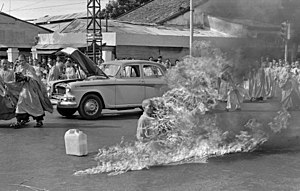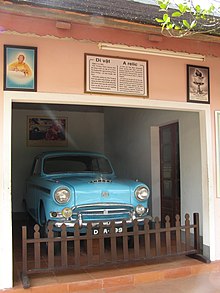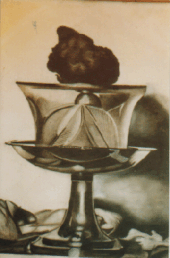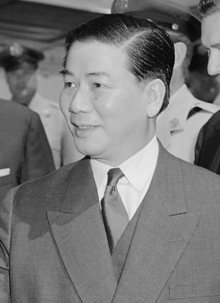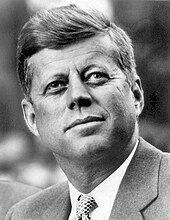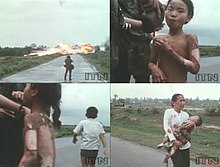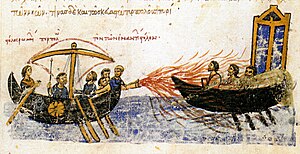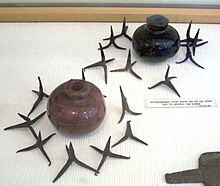Thích
Quảng Đức | |
|---|---|
 | |
| Other names | Bồ Tát Thích Quảng Đức (Bodhisattva Thích Quảng Đức) |
| Personal | |
| Born | 1897 |
| Died | 11 June 1963 (aged 65–66) |
| Cause of death | Burns from self-immolation |
| Religion | Mahayana Buddhism |
| Other names | Bồ Tát Thích Quảng Đức (Bodhisattva Thích Quảng Đức) |
| Senior posting | |
| Based in | South Vietnam |
| Period in office | 1917–1963 |
| Ordination | 1917 |
| Post | Chairman of the Panel on Ceremonial Rites of the Congregation of Vietnamese Monks Abbot of the Phước Hòa pagoda |
Thích Quảng Đức was a Vietnamese Mahayana Buddhist monk who burned himself to death at a busy Saigon road intersection on 11 June 1963. Quảng Đức was protesting the persecution of Buddhists by the South Vietnamese government led by Ngô Đình Diệm. Photographs of his self-immolation were circulated widely across the world and brought attention to the policies of the Diệm government. John F. Kennedy said in reference to a photograph of Đức on fire, "No news picture in history has generated so much emotion around the world as that one." Malcolm Browne won a Pulitzer Prize for his photograph of the monk's death.
Quảng Đức's act increased international pressure on Diệm and led him to announce reforms with the intention of mollifying the Buddhists. However, the promised reforms were not implemented, leading to a deterioration in the dispute. As protests continued, the ARVN Special Forces loyal to Diệm's brother, Ngô Đình Nhu, launched nationwide raids on Buddhist pagodas, seizing Quảng Đức's heart and causing deaths and widespread damage. Several Buddhist monks followed Quảng Đức's example, also immolating themselves. Eventually, a U.S.-backed Army coup toppled Diệm, who was assassinated on 2 November 1963.
Biography
Accounts
of the life of Quảng Đức are derived from information disseminated by
Buddhist organizations. He was born in the village of Hội Khánh, in Vạn Ninh District of Khánh Hòa Province in central Vietnam as Lâm Văn Túc,
one of seven children of Lâm Hữu Ứng and his wife, Nguyễn Thị Nương. At
the age of seven, he left to study Buddhism under Hòa thượng Thích
Hoằng Thâm, who was his maternal uncle and spiritual master. Thích Hoằng
Thâm raised him as a son and Lâm Văn Túc changed his name to Nguyễn Văn Khiết. At age 15, he took the samanera (novice) vows and was ordained as a monk at age 20 under the dharma name Thích Quảng Đức. The Vietnamese name Thích (釋) is from "Thích Ca" or "Thích Già" (釋迦), means "of the Shakya clan." After ordination, he traveled to a mountain near Ninh Hòa, vowing to live the life of a solitary Buddhism-practicing hermit for three years. He returned in later life to open the Thien Loc pagoda at his mountain retreat.
After his self-imposed isolation ended, he began to travel around central Vietnam expounding the dharma. After two years, he went into retreat at the Sac Tu Thien An pagoda near Nha Trang.
In 1932, he was appointed an inspector for the Buddhist Association in
Ninh Hòa before becoming the inspector of monks in his home province of
Khánh Hòa. During this period in central Vietnam, he was responsible for
the construction of 14 temples.
In 1934, he moved to southern Vietnam and traveled throughout the
provinces spreading Buddhist teachings. During his time in southern
Vietnam, he also spent two years in Cambodia studying the Theravada Buddhist tradition.
Upon his return from Cambodia, he oversaw the construction of a
further 17 new temples during his time in the south. The last of the 31
new temples that he was responsible for constructing was the Quan The Am pagoda in the Phú Nhuận District of Gia Định Province on the outskirts of Saigon.
The street on which the temple stands was later renamed Quảng Đức
Street in 1975. After the temple-building phase, Đức was appointed to
serve as the Chairman of the Panel on Ceremonial Rites of the
Congregation of Vietnamese Monks, and as abbot of the Phuoc Hoa pagoda, which was the initial location of the Association for Buddhist Studies of Vietnam (ABSV). When the office of the ABSV was relocated to the Xá Lợi Pagoda, the main pagoda of Saigon, Đức resigned.
Self-immolation
Religious background
A memorial to Quảng Đức located on the site of his death
In a country where surveys of the religious composition at the time
estimated the Buddhist majority to be between 70 and 90 percent, President Diệm was a member of the Catholic
minority, and pursued discriminatory policies favoring Catholics for
public service and military promotions, as well as in the allocation of
land, business arrangements and tax concessions.
Diệm once told a high-ranking officer, forgetting that the officer was
from a Buddhist family, "Put your Catholic officers in sensitive places.
They can be trusted." Many officers in the Army of the Republic of Vietnam (ARVN) converted to Roman Catholicism as their military prospects depended on it.
Additionally, the distribution of firearms to village self-defense
militias saw weapons given only to Roman Catholics, with some Buddhists
in the army being denied promotion if they refused to convert to Roman
Catholicism.
Some Catholic priests ran their own private armies, and there were forced conversions and looting, shelling, and demolition of pagodas in some areas, to which the government turned a blind eye. Some Buddhist villages converted en masse to receive aid or avoid being forcibly resettled by Diệm's regime.
The "private" status that was imposed on Buddhism by the French, which
required official permission to be obtained by those wishing to conduct
public Buddhist activities, was not repealed by Diệm. Catholics were also de facto exempt from corvée
labor, which the government obliged all citizens to perform, and United
States aid was distributed disproportionately to Catholic majority
villages by Diệm's regime.
The Catholic Church was the largest landowner in the country and
enjoyed special exemptions in property acquisition, and land owned by
the Catholic Church was exempt from land reform. The white and gold Vatican flag was regularly flown at all major public events in South Vietnam, and Diệm dedicated his country to the Virgin Mary in 1959.
Buddhist discontent erupted following a ban in early May on flying the Buddhist flag in Huế on Vesak, the birthday of Gautama Buddha. Just days before, Catholics had been encouraged to fly the Vatican flag at a celebration for Archbishop Ngô Đình Thục
of Huế, Diệm's elder brother. A large crowd of Buddhists protested the
ban, defying the government by flying Buddhist flags on the Buddhist
holy day of Vesak and marching on the government broadcasting station.
Government forces fired into the crowd of protesters, killing nine
people. Diệm's refusal to take responsibility—he blamed the Viet Cong for the deaths—led to further Buddhist protests and calls for religious equality. As Diem remained unwilling to comply with Buddhist demands, the frequency of protests increased.
Day of the act
Journalist Malcolm Browne's photograph of Quảng Đức during his self-immolation; a similar photograph won the 1963 World Press Photo of the Year.
The car in which Quảng Đức traveled to his self-immolation; Huế, Thiên Mụ Pagoda.
On 10 June 1963, U.S. correspondents were informed that "something
important" would happen the following morning on the road outside the
Cambodian embassy in Saigon. Most of the reporters disregarded the message, since the Buddhist crisis had at that point been going on for more than a month, and the next day only a few journalists turned up, including David Halberstam of The New York Times and Malcolm Browne, the Saigon bureau chief for the Associated Press (AP).
Đức arrived as part of a procession that had begun at a nearby pagoda.
Around 350 monks and nuns marched in two phalanxes, preceded by an Austin Westminster sedan,
carrying banners printed in both English and Vietnamese. They denounced
the Diệm government and its policy towards Buddhists, demanding that it
fulfill its promises of religious equality. Another monk offered himself, but Đức's seniority prevailed.
The act occurred at the intersection of Phan Đình Phùng Boulevard (now Nguyễn Đình Chiểu Street) and Lê Văn Duyệt Street (now Cách Mạng Tháng Tám Street) (10.7750°N 106.6868°E), a few blocks southwest of the Presidential Palace
(now the Reunification Palace). Đức emerged from the car along with two
other monks. One placed a cushion on the road while the second opened
the trunk and took out a five-gallon petrol can. As the marchers formed a
circle around him, Đức calmly sat down in the traditional Buddhist
meditative lotus position on the cushion. A colleague emptied the contents of the petrol container over Đức's head. Đức rotated a string of wooden prayer beads and recited the words Nam mô A Di Đà Phật ("Homage to Amitābha Buddha")
before striking a match and dropping it on himself. Flames consumed his
robes and flesh, and black oily smoke emanated from his burning body.
Đức's last words before his self-immolation were documented in a letter he had left:
"Before closing my eyes and moving towards the vision of the Buddha, I respectfully plead to President Ngô Đình Diệm to take a mind of compassion towards the people of the nation and implement religious equality to maintain the strength of the homeland eternally. I call the venerables, reverends, members of the sangha and the lay Buddhists to organize in solidarity to make sacrifices to protect Buddhism."
David Halberstam wrote:
"I was to see that sight again, but once was enough. Flames were coming from a human being; his body was slowly withering and shriveling up, his head blackening and charring. In the air was the smell of burning human flesh; human beings burn surprisingly quickly. Behind me I could hear the sobbing of the Vietnamese who were now gathering. I was too shocked to cry, too confused to take notes or ask questions, too bewildered to even think ... As he burned he never moved a muscle, never uttered a sound, his outward composure in sharp contrast to the wailing people around him."
The spectators were mostly stunned into silence, but some wailed and
several began praying. Many of the monks and nuns, as well as some
shocked passersby, prostrated themselves before the burning monk. Even
some of the policemen, who had orders to control the gathered crowd, prostrated before him.
In English and Vietnamese,
a monk repeated into a microphone: "A Buddhist priest burns himself to
death. A Buddhist priest becomes a martyr." After approximately 10
minutes, Đức's body was fully immolated and it eventually toppled
backwards onto its back. Once the fire subsided, a group of monks
covered the smoking corpse with yellow robes, picked it up and tried to
fit it into a coffin, but the limbs could not be straightened and one of
the arms protruded from the wooden box as he was carried to the nearby
Xá Lợi Pagoda in central Saigon. Outside the pagoda, students unfurled
bilingual banners which read: "A Buddhist priest burns himself for our
five requests."
By 1:30 pm (13:30), around 1,000 monks had congregated inside to
hold a meeting, while outside a large crowd of pro-Buddhist students had
formed a human barrier around it. The meeting soon ended and all but
100 monks slowly left the compound. Nearly 1,000 monks, accompanied by laypeople,
returned to the cremation site. The police lingered nearby. At around
6:00 pm (18:00), thirty nuns and six monks were arrested for holding a
prayer meeting on the street outside Xá Lợi. The police encircled the
pagoda, blocking public passage and giving observers the impression that
an armed siege was imminent by donning riot gear.
Funeral and aftermath
After
the self-immolation, the U.S. put more pressure on Diệm to re-open
negotiations on the faltering agreement. Diệm had scheduled an emergency
cabinet meeting at 11:30 on 11 June to discuss the Buddhist crisis
which he believed to be winding down. Following Đức's death, Diệm
canceled the meeting and met individually with his ministers. Acting
U.S. Ambassador to South Vietnam William Trueheart warned Nguyễn Đình Thuận,
Diệm's Secretary of State, of the desperate need for an agreement,
saying that the situation was "dangerously near breaking point" and
expected Diệm would meet the Buddhists' five-point manifesto. United States Secretary of State Dean Rusk warned the Saigon embassy that the White House would publicly announce that it would no longer "associate itself" with the regime if this did not occur. The Joint Communiqué and concessions to the Buddhists were signed on 16 June.
15 June was set as the date for the funeral, and on that day
4,000 people gathered outside the Xá Lợi pagoda, only for the ceremony
to be postponed. On 19 June, his remains were carried out of Xá Lợi to a
cemetery 16 kilometers (9.9 mi) south of the city for a re-cremation
and funeral ceremony. Following the signing of the Joint Communiqué,
attendance was limited by agreement between Buddhist leaders and police
to approximately 500 monks.
Intact heart and symbolism
The heart relic of Quảng Đức
The body was re-cremated during the funeral, but Đức's heart remained intact and did not burn. It was considered to be holy and placed in a glass chalice at Xá Lợi Pagoda. The intact heart relic is regarded as a symbol of compassion. Đức has subsequently been revered by Vietnamese Buddhists as a bodhisattva (Bồ Tát), and accordingly is often referred to in Vietnamese as Bồ Tát Thích Quảng Đức. On 21 August, the ARVN Special Forces
of Nhu attacked Xá Lợi and other Buddhist pagodas across Vietnam. The
secret police intended to confiscate Đức's ashes, but two monks had
escaped with the urn, jumping over the back fence and finding safety at
the U.S. Operations Mission next door. Nhu's men managed to confiscate Đức's charred heart.
The location chosen for the self-immolation, in front of the
Cambodian embassy, raised questions as to whether it was coincidence or a
symbolic choice. Trueheart and embassy official Charles Flowerree felt
that the location was selected to show solidarity with the Cambodian
government of Prince Norodom Sihanouk.
South Vietnam and Cambodia had strained relations: in a speech on 22
May, Sihanouk had accused Diệm of mistreating Vietnamese and ethnic
minority Khmer Buddhists. The pro-Diệm Times of Vietnam
published an article on 9 June which claimed that Cambodian monks had
been encouraging the Buddhist crisis, asserting it was part of a
Cambodian plot to extend its neutralist foreign policy into South
Vietnam. Flowerree noted that Diệm was "ready and eager to see a fine
Cambodian hand in all the organized Buddhist actions".
Diệm reaction
Diệm made a radio address at 19:00 on the day of Đức's death,
asserting that he was profoundly troubled by the event. He appealed for
"serenity and patriotism", and announced that stalled negotiations would
resume with the Buddhists. He claimed that negotiations had been
progressing well and in a time of religious tension emphasized the role
of the Roman Catholic philosophy of personalism
in his rule. He alleged that extremists had twisted the facts and he
asserted that the Buddhists can "count on the Constitution, in other
words, me."
The ARVN responded to the appeal, putting on a show of solidarity
behind Diệm to isolate dissident officers. Thirty high-ranking officers
headed by General Lê Văn Tỵ
declared their resolve to carry out all missions entrusted to the army
for the defense of the constitution and the Republic. The declaration
was a veneer which masked a developing plot to oust Diệm. Some of the signatories were to become personally involved in Diệm's overthrow and death in November. Generals Dương Văn Minh and Trần Văn Đôn, the presidential military advisor and the chief of the army who were to lead the coup, were overseas.
Madame Nhu (a Catholic convert from Buddhism and the wife of Diệm's younger brother and chief adviser Ngô Đình Nhu),
who was regarded as the First Lady of South Vietnam at the time (as
Diệm was a bachelor), said she would "clap hands at seeing another monk
barbecue show". Later that month, Diệm's government charged that Đức had been drugged before being forced to commit suicide. The regime also accused Browne of bribing Đức to burn himself.
Political and media impact
Photographs taken by Malcolm Browne of the self-immolation quickly spread across the wire services and were featured on the front pages of newspapers worldwide. The self-immolation was later regarded as a turning point in the Buddhist crisis and a critical point in the collapse of the Diệm regime.
Historian Seth Jacobs
asserted that Đức had "reduced America's Diệm experiment to ashes as
well" and that "no amount of pleading could retrieve Diệm's reputation"
once Browne's images had become ingrained into the psyche of the world
public. Ellen Hammer
described the event as having "evoked dark images of persecution and
horror corresponding to a profoundly Asian reality that passed the
understanding of Westerners." John Mecklin,
an official from the U.S. embassy, noted that the photograph "had a
shock effect of incalculable value to the Buddhist cause, becoming a
symbol of the state of things in Vietnam." William Colby, then chief of the Central Intelligence Agency's
Far East Division, opined that Diệm "handled the Buddhist crisis fairly
badly and allowed it to grow. But I really don't think there was much
they could have done about it once that bonze burned himself."
U.S. President John F. Kennedy said that "no news picture in history has generated so much emotion around the world as that one."
President John F. Kennedy,
whose government was the main sponsor of Diệm's regime, learned of
Đức's death when handed the morning newspapers while he was talking to
his brother, Attorney General Robert F. Kennedy, on the phone. Kennedy reportedly interrupted their conversation about segregation in Alabama
by exclaiming "Jesus Christ!" He later remarked that "no news picture
in history has generated so much emotion around the world as that one." U.S. Senator Frank Church (D-ID), a member of the Senate Foreign Relations Committee, claimed that "such grisly scenes have not been witnessed since the Christian martyrs marched hand in hand into the Roman arenas."
In Europe, the photographs were sold on the streets as postcards during the 1960s, and communist China distributed millions of copies of the photograph throughout Asia and Africa as evidence of what it called US imperialism. One of Browne's photographs remains affixed to the sedan in which Đức was riding and is part of a tourist attraction in Huế.
For Browne and the AP, the pictures were a marketing success. Ray Herndon, the United Press International
(UPI) correspondent who had forgotten to take his camera on the day,
was harshly criticized in private by his employer. UPI estimated that
5,000 readers in Sydney, then a city of around 1.5–2 million, had
switched to AP news sources.
Diệm's English-language mouthpiece, the Times of Vietnam,
intensified its attacks on both journalists and Buddhists. Headlines
such as "Xá Lợi politburo makes new threats" and "Monks plot murder"
were printed.
One article questioned the relationship between the monks and the press
by posing the question as to why "so many young girls are buzzing in
and out of Xá Lợi early [in the day]" and then going on to allege that
they were brought in for sexual purposes for the U.S. reporters.
Browne's award-winning photograph of Đức's death has been
reproduced in popular media for decades, and the incident has been used
as a touchstone reference in many films and television programs.
A still photograph of Đức's self-immolation taken by Browne was used for the cover of American rap metal band Rage Against the Machine's debut album which came out in 1992, as well as the cover of their single "Killing in the Name".
Precedents and influence
Despite
the shock of the Western public, the practice of Vietnamese monks
self-immolating was not unprecedented. Instances of self-immolations in
Vietnam had been recorded for centuries, usually carried out to honor
Gautama Buddha. The most recently recorded case had been in North
Vietnam in 1950. The French colonial
authorities had tried to eradicate the practice after their conquest of
Vietnam in the nineteenth century, but had not been totally successful.
They did manage to prevent one monk from setting fire to himself in Huế
in the 1920s, but he managed to starve himself to death instead. During
the 1920s and 1930s, Saigon newspapers reported multiple instances of
self-immolations by monks in a matter-of-fact style. The practice had
also been seen in the Chinese city of Harbin in 1948 when a monk seated down in the lotus position on a pile of sawdust and soybean oil and set fire to himself in protest against the treatment of Buddhism by the communists of Mao Zedong. His heart remained intact, as did that of Đức.
The Venerable Thich Quảng Đức Monument at the intersection where Quảng Đức performed his self-immolation, Phan Đình Phùng (now Nguyễn Đình Chiểu) Street and Lê Văn Duyệt (now Cach Mạng Thang Tam) Street (10.775159°N 106.686864°E)
After Đức, five more Buddhist monks self-immolated up until late October 1963 as the Buddhist protests in Vietnam escalated. On 1 November, the ARVN overthrew Diệm in a coup. Diệm and Nhu were assassinated the next day. Monks have followed Đức's example since for other reasons.
Đức's actions were copied by United States citizens in protests against the Vietnam War:
- Alice Herz, an 82-year-old longtime peace activist, self-immolated on March 16, 1965, on a street in Detroit, Michigan.
- Norman Morrison, a 31-year-old Quaker pacifist, poured kerosene over himself and set himself alight below the third-floor window of Secretary of Defense Robert McNamara at the Pentagon on 2 November 1965.
- Roger Allen LaPorte burned himself to death outside the United Nations building in New York City on 9 November 1965.
- Florence Beaumont self-immolated outside the Federal Building in Los Angeles on 15 October 1967.
- George Winne, Jr., a student, self-immolated on 10 May 1970 on the campus of the University of California, San Diego and died the following day.
In an apparently non-political case of imitation of Quảng Đức, the
young son of an American officer based at the U.S. Embassy in Saigon
doused himself with gasoline and set himself on fire. He was seriously
burned before the fire was extinguished and later could only offer the
explanation that "I wanted to see what it was like."

